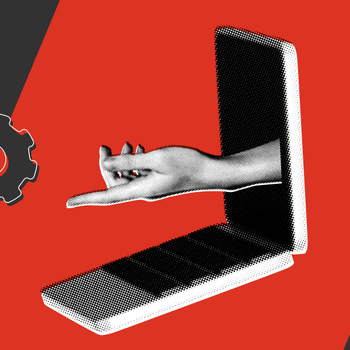How To Turn Prospects Into Customers With Full-Funnel Marketing
by Quinn Curtis • March 19, 2022
If you’re like most business leaders, you’re always interested in learning about new marketing strategies. Maybe you’ve already heard the buzz about full-funnel marketing, but you’re not quite sure how it works. Or maybe you’re wondering, “What is a marketing funnel?” Don’t worry — we have you covered. Keep reading for everything you need to know about what full-funnel marketing is and how your business can implement the new approach.
Full-Funnel Marketing Explained
Full-funnel marketing is a disruptive new approach to marketing, designed for the way consumers make decisions today.
Traditionally, marketing uses a “funnel” system that breaks the buying process into marketing funnel stages, from the “lead” stage — in which consumers first signal their interest in the product — all the way to the final stage in which the consumer finally makes the purchase.
Full-funnel marketing, by contrast, does not separate the different stages of the buying journey. Instead, they are all considered together as part of the same process. You nurture your leads at every stage. Full-funnel marketing also makes use of the latest technologies to impact every aspect of the buying process.
Stages of the Marketing Funnel
The marketing funnel can be divided into three basic stages: awareness, consideration, and conversion. Here’s how each stage generally works.
Awareness
The awareness stage is traditionally seen as the beginning of the buyer’s journey. To put it in technical terms, this is the top-of-funnel marketing stage.
Often, the buyer’s journey begins with a pain point. The consumer experiences a problem and begins to search for a solution. Gradually, as the consumer researches online and talks to their friends, they start to narrow their focus and define the original problem more clearly. They also start to search for a solution to their problem.
At some point during the awareness stage, consumers become aware of your business and the services or products that you offer. Ideally, your products and services will provide a solution to the consumer’s problem.
Of course, you should not be passive during the awareness stage. It’s not solely up to consumers to do their research. Your business can attract customers through marketing outreach, targeted advertising, blogging, social media campaigns, and other forms of marketing. Your goal, during this stage, is to generate leads by collecting the names and contact information of interested consumers so that you can cultivate them later on.
Consideration
During the consideration stage, your marketing team begins to qualify your leads. At this stage, your relationship with consumers becomes more direct and interactive. Your goal is to educate them about everything your business has to offer customers.
Ultimately, the consideration stage is about showing consumers how your business will help them to solve the problem which they identified in the awareness stage.
Promotions, free trials, and curated content are all useful tools during this stage. The more personalized your marketing campaign is during the consideration stage, the better. Social media outreach is a great approach, for this reason, because it allows for rapid and ongoing interactions between your business and prospective customers.
The consideration stage is a key time for building trust. If you can cultivate an open, trusting relationship with consumers, you’ll be well-positioned to build a loyal customer base. After all, you want to do more than just make a few quick conversions. You want to build long-term relationships with consumers who will spread the word about your business.
Conversion
Conversion is the last stage in the marketing funnel. It’s the moment when the consumer pays for their new product, signs up for a subscription, or otherwise becomes a customer.
It’s tempting to think of conversion as the end of the journey. However, if you’re interested in building up a loyal customer base, then conversion is also the beginning of a new journey. That’s why it’s important to make sure that the buying experience is as smooth and pleasant as possible for your customers.
If you’re running an ecommerce business, work hard to remove all possible obstacles in the purchase stage. Consumers love one-click purchase options; they hate having to fill in lengthy forms at the last minute. Streamline your check-out process so that it’s as rapid as possible. You want your customers to leave on a positive note so that they will rave about your business to their friends.
The Purpose Behind Taking a Full-Funnel Approach to Marketing
People don’t shop in the same way they used to — and marketing strategies need to change to reflect that fact.
Consumers today typically start their buying journeys online, where they spend a long time researching their problems and looking for a solution. In the process, they may toggle back and forth between the awareness and the consideration stage. Because they’re researching online, consumers can take in a huge amount of information very rapidly.
A full-funnel approach means that you meet customers where they are and offer them whatever they need at the moment. This approach allows your business to position itself as a subject matter expert for consumers in the consideration stage. At the same time, it allows you to provide more basic information to consumers who are still in the early, awareness stage.
Here are some of the best reasons for taking a full-funnel approach to marketing.
Generate Understanding of the Customer Journey
As we have seen, the full-funnel approach is based on a deep understanding of the way people shop today.
Consumers today are anything but passive. You can’t simply push them through the stages of the old buyer’s journey. Today’s shoppers are amazingly well-informed. They’re surrounded by information constantly. They are active, conscious consumers who want to be fully engaged in their buyer’s journey.
The full-funnel approach reflects that reality and treats it as a feature, not as a bug.
Reach Your Target Audience During Each Phase of the Funnel
A full-funnel strategy takes into account the fact that consumers move rapidly between the different stages of the buying journey. It’s important to be able to tailor your messaging so that you can reach people at every stage.
The full-funnel approach doesn’t just push consumers to make a one-time purchase. Rather, it focuses on developing a lasting relationship with each customer. Given the globalized nature of most sectors, it’s more important than ever to create strong relationships with every client and treat the buyer’s journey as an ongoing, cyclical process rather than as a simple path.
Build Trust With Consumers
Consumers today do most of their research online. They look to social media, blogs, and websites for much of their information.
It’s important to position your business as a reliable and trustworthy source of information. After all, your goal is to have consumers returning to you again and again, throughout the buyer’s journey, as they look for more information and details about products and services. As much as possible, you’ll want to position yourself as an unbiased source of information about your field.
Likewise, your business must provide information in a wide array of formats. At different stages of their journey, your consumers will likely prefer to consume different kinds of information. You should be able to offer social media posts, videos, webinars, and long-form blog posts rich with information. You should provide clients with information about your products and services, but also about your sector in general.
Marketing Tactics for Full Funnel Marketing
It’s easy to see that full-funnel marketing requires a new set of marketing tactics to go along with the new philosophy.
Don’t worry — these new tactics still map onto the stages of the buying journey. They just take into account the fact that the journey isn’t always a straight line. Here’s an overview of how the new approach plays out, stage by stage.
The Awareness Stage
During the awareness stage, it’s a good idea to reach out to as many consumers as possible. Your goal is to spread the word about your products and services and generate interest.
Improve Organic Social Media Presence
Social media is an easy touchpoint for consumers who don’t yet know very much about your product. It doesn’t place a great deal of demand on customers, but it may leave a lasting impression. It also opens a door to consumers who may be interested in learning more about your business in the near future.
For consumers already at a later stage in the buyer’s journey, social media serves to reinforce their interest in your business and to deepen their engagement with you. It can also help to fuel buzz and generate word-of-mouth recommendations, as people engage with your business on social media platforms.
Paid Advertising
Paid advertising — perhaps in the form of Google ads or paid search — can be a good way to educate consumers about the basics of your business. Since consumers are already online, you’ll want to get your name in front of them in as many formats as possible. Paid advertising can also mean video ads, ads on social media, or traditional ads on television.
Again, paid advertising does double duty. It attracts the attention of people in the awareness stage while also reinforcing interest during the consideration stage.
Focus on SEO
SEO is one of the best ways to target advertising at consumers who are already interested in your products. By optimizing your website and your advertising for SEO, you can make sure that consumers who are searching for a specific product will come across your company name.
SEO has the added benefit of being relatively low-cost. And an optimized website, with a well-curated blog, will help you to establish your business as a reliable source of information in your sector. That’s a valuable asset during the consideration stage.
The Consideration Stage
During the consideration stage, consumers are typically searching for more in-depth information. This stage allows you to deepen your engagement with consumers, strengthen your relationship, and continue to build trust. Here are some of the best approaches during this stage.
Create White Papers
White papers do a deep dive into a given subject. They’re an opportunity to showcase everything your business has to offer and to explain exactly how your products and services can solve consumers’ problems.
White papers are not really sales-driven, though. They focus instead of providing information that the consumer can act on. That’s why they are a great way to establish your business as an unbiased source of information about the field.
Video Advertising
Video advertising is immersive and educational. It’s a good way to fully engage consumers and to provide visuals of your products and services. This is especially important for consumers who are carrying out the entire buyer’s journey online.
You’ll want to be able to show them every aspect of your product and how it will fit into their lives. When it’s done right, video advertising can go a long way to build relationships of trust.
The Conversion Stage
The conversion stage is a key moment in the buyer’s journey. It’s when you focus on cultivating loyal customers who will return, again and again, to do business with you. Here’s how you can make that happen.
Segmented Email Campaigns
Segmented email campaigns offer personalized, tailored messages to your loyal customers. You can use segmented email campaigns to remind consumers about upcoming product launches or inform them about the latest developments of their favorite products. Make your customers feel seen and heard so that they’ll want to keep coming back.
Share Testimonials and Reviews
When consumers discover a great product, they’ll want to tell their friends and family about it. In the age of social media, that also means sharing testimonials and review online. Encourage your loyal customers to spread the word about your business. Not only will this generate more buzz for your company but it will also deepen your customers’ sense of engagement with your brand.
How To Implement Full-Funnel Marketing Strategies in Your Business
Full-funnel marketing is one of the most exciting new strategies out there. But it represents a big change. It’s a good idea to get help from experienced, creative marketing pros so that you can get the most out of your new approach.
Disruptive Advertising is a team of digital marketing experts with a passion for connecting great brands like yours with consumers. Get in touch today to learn what we can do for your next campaign.





